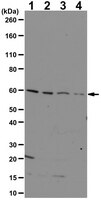ABS1050 Sigma-AldrichAnti-IRX-3
This rabbit polyclonal Anti-IRX-3 Antibody, Cat. No. ABS1050 detects levels of IRX-3, and has been published and validated for use in Western Blotting.
More>> This rabbit polyclonal Anti-IRX-3 Antibody, Cat. No. ABS1050 detects levels of IRX-3, and has been published and validated for use in Western Blotting. Less<<Prodotti consigliati
Panoramica
Tabella delle specifiche principali
| Species Reactivity | Key Applications | Host | Format | Antibody Type |
|---|---|---|---|---|
| M | WB | Rb | Serum | Polyclonal Antibody |
| Product Information | |
|---|---|
| Format | Serum |
| Presentation | Rabbit polyclonal antibody serum with 0.05% sodium azide. |
| Quality Level | MQ100 |
| Packaging Information | |
|---|---|
| Material Size | 100 µL |
| Global Trade Item Number | |
|---|---|
| Numero di catalogo | GTIN |
| ABS1050 | 04054839034640 |







